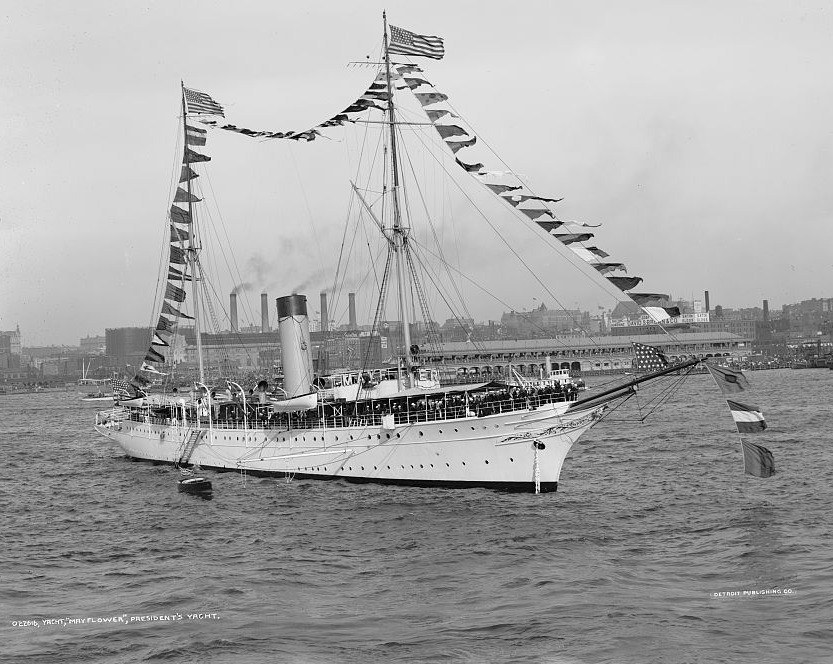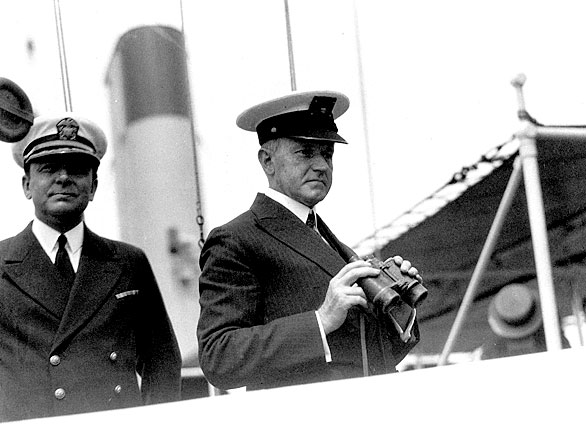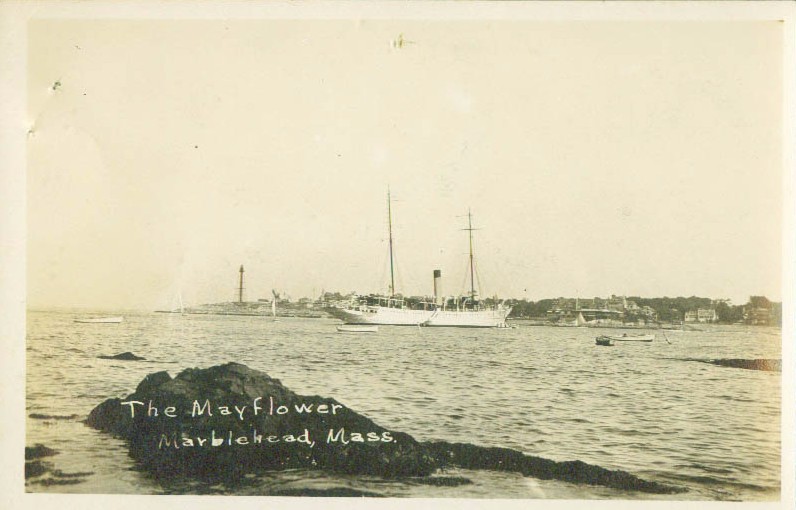By: John Ferrell
Later this month Americans will celebrate Thanksgiving and recall the iconic vessel Mayflower, which in 1620 brought over the first English Pilgrims to the New World.
But there was another vessel, also named Mayflower, that figures more prominently in the Coolidge story. Built nearly three centuries after the fabled Pilgim-bearing ship, the Mayflower we refer to is a ship with an eventful and varied existence that saw it bombard Spanish naval vessels in Cuba, carry U.S. Presidents, ferry refugees to safety, and more.

USS Mayflower in all of her glory, c.1909.
Photo: Library of Congress
The Mayflower was built in 1896, not as a federal vessel, but as a pleasure craft of Ogden Goelet, a New York real-estate mogul. At 273 feet in length and able to reach 17 knots (20 mph), she was a sleek and graceful ship capable of traveling under both steam and sail. The Mayflower was not under Mr. Goelet’s ownership for long because, as the New York Times reported on August 28, 1897, the wealthy businessman passed away from a stroke while vacationing aboard the vessel.
Early in the following year, the United States Navy purchased the Mayflower for $430,000, a third of what Mr. Goelet had paid for her construction, to meet the demand for more vessels to combat the Spanish Navy off the coast of Cuba. TheMayflower was converted into a light warship and given four six-pounder guns and a few machine guns. Her name remained unchanged. While participating in the blockade of Havana, she opened fire upon and hit a Spanish gunboat attempting to flee, driving it back.
In 1905, the Mayflower began a new chapter, one that would put her in many a newsreel and photograph. President Theodore Roosevelt had her re-purposed as a presidential yacht, which could be used to conduct diplomacy in addition to serving as a nautical means of transportation for the Commander-in-Chief. With her long bowsprit, tall masts, elegant lines, and white paint, she was sure to make a good impression on visiting foreign diplomats. In fact, that same year aboard the ship President Roosevelt hosted the formal negotiations between Russia and Japan to end the Russo-Japanese War. The Mayflower continued to serve as the presidential yacht under Presidents Taft, Wilson, Harding, and Coolidge.

President Coolidge stands on the starboard wing of Mayflower in April of 1925, while her captain, Adolphus Andrews, looks on.
Photo: Library of Congress
President Coolidge regularly used the Mayflower, and made direct mention of her a number of times during press conferences. In December of 1923, mere months after being sworn in, Coolidge spoke of his preferred trip on the yacht:
“I think it possible that I shall take a Saturday afternoon trip on the Mayflower tomorrow. I have been our [sic] on it four or five times. Usually we go to Quantico where there is a very good opportunity to turn around, then run back up the river taking dinner on the boat, which is very pleasant, and have some of our friends along.”
During his 1925 stay at Swampscott, Massachusetts Coolidge made much use of the ship. Since Coolidge was staying just off the Atlantic coast, he had ample opportunity to use the vessel for excursions away from the Summer White House of White Court, notably in early July when he sailed down the coast to visit a fortification.
Coolidge wasn’t against the press tagging along on his pleasure cruises, as he relayed in an earlier conference on May 22, 1925:
“I notice that the ladies got ahead of us in getting entertained on the Mayflower. I don’t know whether the men present would be interested to go down on the Mayflower with me some day. You can talk that over among yourselves. If you think you will, let me know and we shall try and arrange an excursion some afternoon.”

Mayflower anchored in the port of Marblehead in 1925, during Coolidge’s stay at Swampscott, MA.
Photo: Vintage Postcard
Having traveled under five presidents, the Mayflower was poised to serve her sixth after President Coolidge handed over the reins to his successor, Herbert Hoover, on March 4, 1929. But it was not to be; President Hoover had the ship stricken shortly after taking office, believing it was an unneeded expense. For the next thirteen years, Mayflower languished and changed hands multiple times, the Great Depression making it understandably hard for anyone to justify the substantial upkeep costs a large luxury yacht entailed. Her situation worsened when, in 1931, she suffered a fire while undergoing conversion to a gunboat for use in Central America.
The outbreak of World War II would see the Mayflower‘s return to service of the nation again. After the United States Coast Guard acquired her in 1942, she underwent her most drastic change to date. The ivory paint was replaced by navy grey, her bowsprit, stately funnel and masts were removed, and the open promenade deck was swapped out for the blocky superstructure, turrets and depth charge racks required of a modern warship. The finishing touch was her official hull-designation: WPG-183. The Mayflower almost looked every bit the part a purpose-built navy ship, except for her sharp bow and steeply inswept stern which conveyed her original purpose.

Once again finding herself a tool of war rather than pleasure, Mayflower (WPG-183) patrols the Atlantic sometime in 1943 with a dramatically altered appearance.
Photo: Naval History and Heritage Command
After the conclusion of World War II, Mayflower joined countless other United States surplus warships in being sold off. Eventually, she was purchased by Collins Distributors Inc. for Mediterranean trade and renamed the USS Mala. In 1948,Mayflower/Mala secretly ferried over Jewish refugees from southern Europe to the new state of Israel. A number of them were from the Exodus, a ship that the year prior had attempted to take thousands of Jews to Palestine before being forcefully turned away by British authorities. In 1950, Mayflower/Mala was purchased by the Israeli Navy and served as a training and patrol craft. In 1955, the vessel was broken up, bringing an end to her storied career.
can you tell me of upcoming events that we can attend. do you still have a christmas season event?